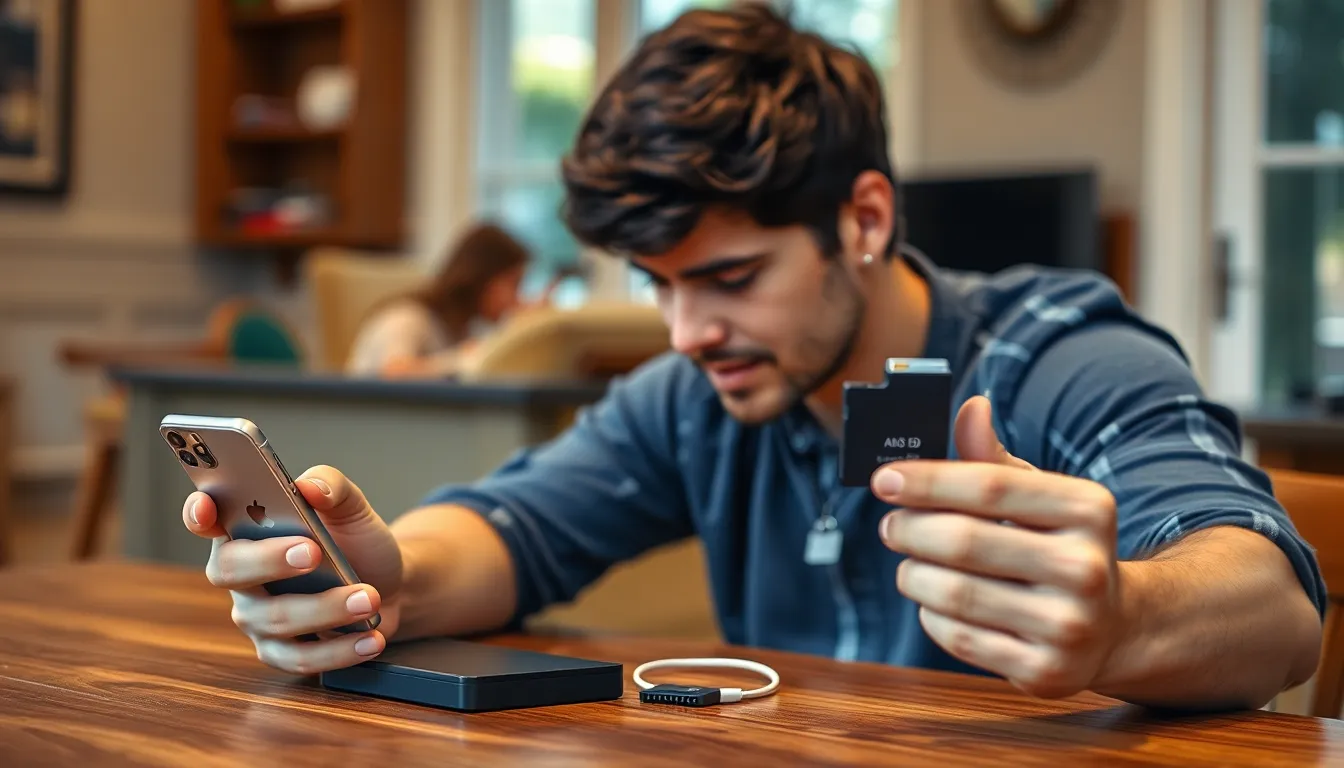Table of Contents
ToggleTransferring photos from an SD card to an iPhone might sound like a techy puzzle, but it’s easier than finding a needle in a haystack—if that needle was a smartphone and the haystack was your photo library. Whether you’re a proud parent capturing every adorable moment or a travel junkie collecting memories, getting those precious snapshots onto your iPhone can feel like a daunting task.
Understanding SD Cards and iPhones
Transferring photos from an SD card to an iPhone requires an understanding of both storage mediums. Familiarity with their characteristics simplifies the process significantly.
Differences in File Systems
SD cards often use the FAT32 or exFAT file system. iPhones, however, utilize a proprietary file system, which affects compatibility. Transfer errors can occur when these systems don’t align. For example, large files may be problematic if they exceed iPhone limits. Knowing these differences helps ensure smooth data transfer without hiccups.
Importance of Proper Connection
A proper connection is crucial for successful data transfer. Using an Apple-approved card reader maintains device integrity. An unreliable adapter can result in failed transfers or data corruption. Ensuring a secure connection also improves transfer speeds. It is necessary to avoid interruptions during the process to protect file integrity.
Methods to Transfer Photos


Transferring photos from an SD card to an iPhone offers several effective methods. Each method suits different user preferences and equipment availability.
Using a Card Reader
A card reader serves as a direct link between the SD card and the iPhone. Users connect the card reader to their device, which typically supports the Lightning connector for iPhones. Once connected, accessing the Files app allows the user to navigate to the SD card and select the desired photos. The iPhone recognizes the files, enabling a straightforward transfer process. After selecting the photos, users can copy them directly into the iPhone’s photo library, ensuring they keep cherished memories.
Using an Adapter
An adapter provides another practical way to transfer photos. Lightning to SD card camera adapters are specifically designed for this purpose. Users insert the SD card into the adapter, then plug it into the iPhone. Access the Photos app, where a prompt appears, displaying the images available for import. Users can easily select which photos to transfer, ensuring only the preferred ones make it to their device. This method typically offers a user-friendly experience while ensuring compatibility with iOS systems.
Software Solutions
Transferring photos from an SD card to an iPhone can also be achieved through software solutions. These options provide users with flexibility and convenience.
Third-Party Apps
Numerous third-party apps streamline the transfer process. Applications like PhotoSync and Google Photos support seamless communication between an SD card and an iPhone. Users can install these apps directly from the App Store and follow simple interface prompts. After connecting the SD card, the apps recognize the files, allowing users to select and import images easily. Many of these apps offer additional features like cloud storage options and automatic backups, enhancing overall photo management.
Built-in iOS Features
Built-in iOS features facilitate transferring photos without needing extra software. The Photos app allows users to import images directly from an SD card connected via an adapter. After connecting the adapter, users open the Photos app where they can find the import option. A list of images appears on the screen, making it easy to select specific ones for transfer. This method ensures compatibility and efficiency, streamlining the import process directly onto the iPhone.
Troubleshooting Common Issues
Transferring photos from an SD card to an iPhone can sometimes present challenges. Identifying and fixing these common problems ensures a smoother experience.
Connection Problems
Sometimes, issues arise due to the card reader connection. Ensure the card reader is Apple-approved to guarantee compatibility. Users should double-check that the adapter is securely plugged into the Lightning port. If the iPhone doesn’t recognize the SD card, try removing and reinserting the card, as a loose connection might be the culprit. Restarting the iPhone can also resolve temporary glitches affecting the connection. Checking for software updates on the iPhone might improve compatibility with external devices and ensure the latest features.
File Format Compatibility
Compatibility issues frequently occur with file formats. SD cards typically store photos in JPEG or RAW formats, while iPhones read these formats without difficulty. However, images in unsupported formats might not transfer correctly. Users need to confirm the file types stored on the SD card before transfer. Converting unsupported formats into compatible ones can be done before the transfer process. Accessing this information through a computer or an additional device might simplify the checking process. Ensuring that file formats align with the iPhone’s capabilities enhances successful photo imports.
Transferring photos from an SD card to an iPhone doesn’t have to be a daunting task. With the right tools and knowledge, users can easily move their cherished memories to their devices. Whether opting for a card reader or leveraging third-party apps, the process is straightforward and accessible.
Staying aware of compatibility issues and utilizing Apple-approved accessories can make all the difference in ensuring a smooth transfer. By following the outlined methods and tips, anyone can enjoy their favorite photos on their iPhone in no time. Embracing these techniques not only enhances photo management but also preserves precious moments for years to come.





